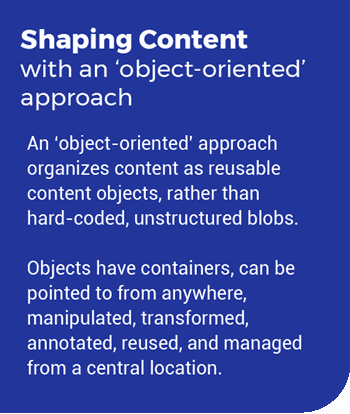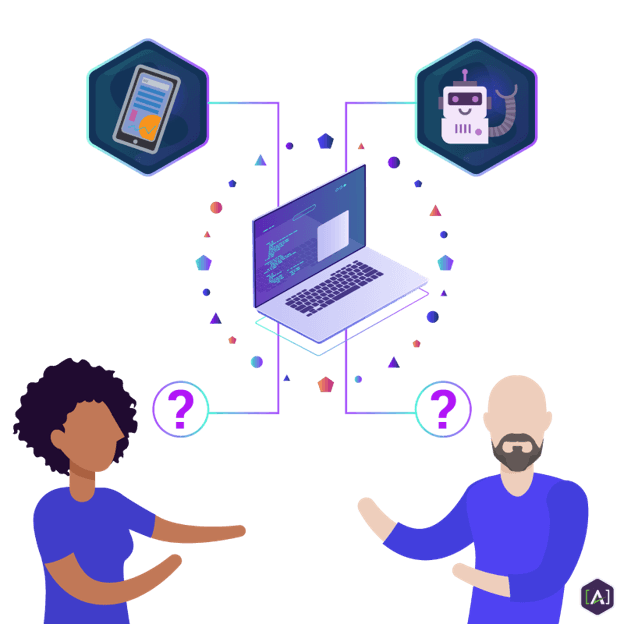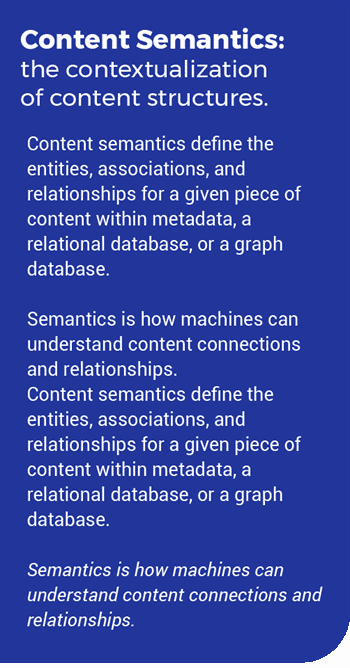Utilize Content-as-a-Service Architecture to customize content for Audience Segments and Customer Types
Publishing  is rooted in a long tradition of creating one (sometimes immense) version of content intended to meet the needs of all readers. Although content has moved beyond paper for almost 30 years, many of us follow workflows or mindset strategies that are still rooted in the past.
is rooted in a long tradition of creating one (sometimes immense) version of content intended to meet the needs of all readers. Although content has moved beyond paper for almost 30 years, many of us follow workflows or mindset strategies that are still rooted in the past.
Our customers now begin their content consumption via almost any touchpoint: there is no real equivalent of opening a book and scanning a table of contents to select where to begin. The customer’s first contact with your content may begin in an app, in an extract within a social post, through a voice assistant query, or through a more traditional chunk of content in web pages or PDFs.
We must deliver content within the context of where the customer is in their journey, while keeping in mind their intent. The source, 'a set of core, integrated, and shared content object, must be capable of delivering content in targeted forms. This capability begins with the creation of content via modular authoring, and ends with flexible content delivery.
 is rooted in a long tradition of creating one (sometimes immense) version of content intended to meet the needs of all readers. Although content has moved beyond paper for almost 30 years, many of us follow workflows or mindset strategies that are still rooted in the past.
is rooted in a long tradition of creating one (sometimes immense) version of content intended to meet the needs of all readers. Although content has moved beyond paper for almost 30 years, many of us follow workflows or mindset strategies that are still rooted in the past. Our customers now begin their content consumption via almost any touchpoint: there is no real equivalent of opening a book and scanning a table of contents to select where to begin. The customer’s first contact with your content may begin in an app, in an extract within a social post, through a voice assistant query, or through a more traditional chunk of content in web pages or PDFs.
We must deliver content within the context of where the customer is in their journey, while keeping in mind their intent. The source, 'a set of core, integrated, and shared content object, must be capable of delivering content in targeted forms. This capability begins with the creation of content via modular authoring, and ends with flexible content delivery.
Delivering the right content to the right customer, at the right time
Content creation must evolve into a more efficient, intelligent experience. Ideally, our methods will identify the intent of a customer, and subsequently pull from the content pool to deliver the right content at the right time.
The challenge is producing variant copy from different authoring teams that fit into a core content model. This allows content strategists and content engineers to assemble relevant end-views for multiple customer journeys, in stark contrast to the traditional roots of publishing.
This new methodology allows content to become adaptable. It can now serve all of an enterprise’s customer personas, rather than producing a single, static rendering that is awkward to update and which dilutes the experience for each audience.
The challenge is producing variant copy from different authoring teams that fit into a core content model. This allows content strategists and content engineers to assemble relevant end-views for multiple customer journeys, in stark contrast to the traditional roots of publishing.
This new methodology allows content to become adaptable. It can now serve all of an enterprise’s customer personas, rather than producing a single, static rendering that is awkward to update and which dilutes the experience for each audience.

Personalizing Content: the Power of Content Models
There are varying levels of technical content that are appropriate for different users. For example:
- An overview (e.g. summary or outline) of technical content would be appropriate for a well-versed potential customer, who wants to explore product capabilities.
- A more dense level of technical content is appropriate for customer support and troubleshooting. Product settings may be described that would make sense for a consumer who has already purchased the product.
These two users, while pulling from the same content pool, have incredibly different needs and levels of technical expertise.

Successfully serving both users can only be accomplished if we have a content model that provides elements that can support both personas within the authoring process and lifecycle.
The  authoring may very likely be performed by different creators; but the content must be spawned from a single content reference. Success is ensured by a structural model that can accommodate both modular and variant content elements.
authoring may very likely be performed by different creators; but the content must be spawned from a single content reference. Success is ensured by a structural model that can accommodate both modular and variant content elements.
 authoring may very likely be performed by different creators; but the content must be spawned from a single content reference. Success is ensured by a structural model that can accommodate both modular and variant content elements.
authoring may very likely be performed by different creators; but the content must be spawned from a single content reference. Success is ensured by a structural model that can accommodate both modular and variant content elements.The key to success here is a Core Content Model (CCM), integrated with and supported by a Core Semantic Model (CSM). CCM is a single, integrated model that defines how content assets will be structured and represented throughout their complete content lifecycle.
A Core Semantic Model a comprehensive model that defines concepts and their relationships, as well as the terminology for identifying them, across domains and across systems in the content lifecycle. As a particular type of Semantic Model, a Core Semantic Model is designed to address specific requirements; in particular, it aims to define a common or, at least, coordinated Content Semantic, such that, wherever the content goes the labels used to identify what it is and how it can be used relate the same meaning.
A Core Semantic Model a comprehensive model that defines concepts and their relationships, as well as the terminology for identifying them, across domains and across systems in the content lifecycle. As a particular type of Semantic Model, a Core Semantic Model is designed to address specific requirements; in particular, it aims to define a common or, at least, coordinated Content Semantic, such that, wherever the content goes the labels used to identify what it is and how it can be used relate the same meaning.
The CCM and CSM methodology from [A] helps to align all content types and elements, along with variations.
They also ensure that an enterprise can integrate strategic outcomes into a structural model used to guide the development of authoring, and manage the layers that contain those structured content elements.
They also ensure that an enterprise can integrate strategic outcomes into a structural model used to guide the development of authoring, and manage the layers that contain those structured content elements.
The Relationship between Structure and Semantics
- Content structure
 is the physical organization of content. It addresses the fundamental needs of publishing - presenting content to consumers.
is the physical organization of content. It addresses the fundamental needs of publishing - presenting content to consumers. - Content Semantics is the association of specific meanings with specific content structures. Meanings are established as a context within a semantic model.
- A Semantic model defines and organizes concepts within knowledge domains, with key examples being:
- Taxonomy - a classification scheme
- Thesaurus - a rubric defining & relating terms
- Ontology - a formal, machine-interpretable domain model
By itself, modular content accomplishes little. A potent combination of structure and semantics is necessary to infuse content with the intelligence needed to make it responsive and useful to a positive customer experience.
Handling Variant Presentations
Once we have component-based content objects developed against a Core Content Model (CCM), we are able to begin thinking about how the content gets delivered into experiences. In order to do that, we need to build a modular presentation and a customer experience layer.
Many organizations already have a design system in place that deals with component-based CSS for various renderings of content. We need to work with existing pattern libraries to ensure internal adaptation of established content presentation for new variable elements.
The front-end should directly reference the content elements within the model, and be able to accommodate the new shapes of content. A modular presentation layer allows content to to be displayed efficiently and intelligently, mirroring the internal content processes.
Many organizations already have a design system in place that deals with component-based CSS for various renderings of content. We need to work with existing pattern libraries to ensure internal adaptation of established content presentation for new variable elements.
The front-end should directly reference the content elements within the model, and be able to accommodate the new shapes of content. A modular presentation layer allows content to to be displayed efficiently and intelligently, mirroring the internal content processes.
Semantics: Uniting Customers with Relevant Content
In order to connect modular presentation and the conditional rules associated with segmenting content into the targeted audiences, we need to add in a layer of shared tags. This can be a full-fledged semantic system based on detailed ontologies, or a very simple, taxonomy driven tag set. Regardless of the complexity, an enterprise must be able to connect the audience’s contextual data with the componentized content to match intent with a response. Having a coherent set of organized tags shared amongst systems is the only way to accomplish this.
Bring it together with Content-as-a-Service
In  order to connect our content components with the modular presentation, we need a flexible infrastructure for content to move within. Fortunately, most content technology vendors have been moving in this direction of API access for content sets. This applies to content ingestion via API, and making content further available for consumption.
order to connect our content components with the modular presentation, we need a flexible infrastructure for content to move within. Fortunately, most content technology vendors have been moving in this direction of API access for content sets. This applies to content ingestion via API, and making content further available for consumption.
 order to connect our content components with the modular presentation, we need a flexible infrastructure for content to move within. Fortunately, most content technology vendors have been moving in this direction of API access for content sets. This applies to content ingestion via API, and making content further available for consumption.
order to connect our content components with the modular presentation, we need a flexible infrastructure for content to move within. Fortunately, most content technology vendors have been moving in this direction of API access for content sets. This applies to content ingestion via API, and making content further available for consumption. Content technology vendors are generally starting to recognize the needs of portable content. This bodes well for enterprise publishers who need to move towards discreet, encapsulated, service-oriented architectures for content portability.
Content, regardless of source, ultimately needs to be made available through a centralized API call, in a CaaS Architecture.
Building and maintaining a CCM is a fundamental ingredient to align disparate content technologies from originating departments. That way, content can flow between producers that may be creating different types of content from technical to non-technical, from pre-sales to post-sales, from market-to-market. All of these content assets can flow together into a single set of integrated core content that can be made available to diverse customer experiences without regard to originating systems.
Adaptive Content Transformation
The movement towards adaptive content experiences via CaaS architectures has been driving the evolution of content operating models across the enterprise, forging a new era of innovation of which we are all participants and consumers. Since this is a massive, evolving process, it might not feel like a revolution. But it is taking place among knowledge-producing enterprises the world over.
In working with dozens of the largest knowledge holders and enterprise publishers on earth, [A] has consistently witnessed and facilitated fundamental, substantial change across publishing teams. The new model is in motion. It has become clear that no one in content practice is satisfied with the status quo. [A] clients inspire us with their advocacy in content change in all levels of an enterprise. It's not as hard as you might think to become a content change advocate. Change is happening everyday, and it's time for all of us in the content industry to do our part to shift the conversation toward intelligence.
Further reading and Resources
Ready to get moving on making your content more intelligent? Download the [A] Guide to the Core Content Model.



